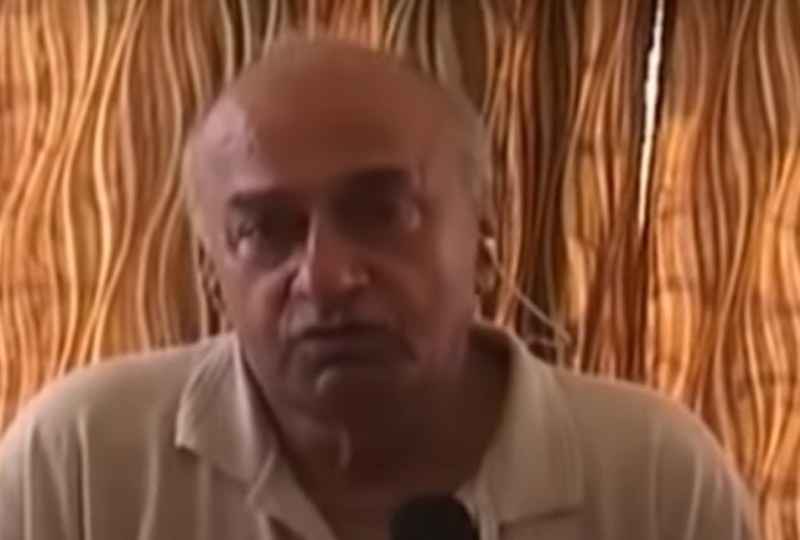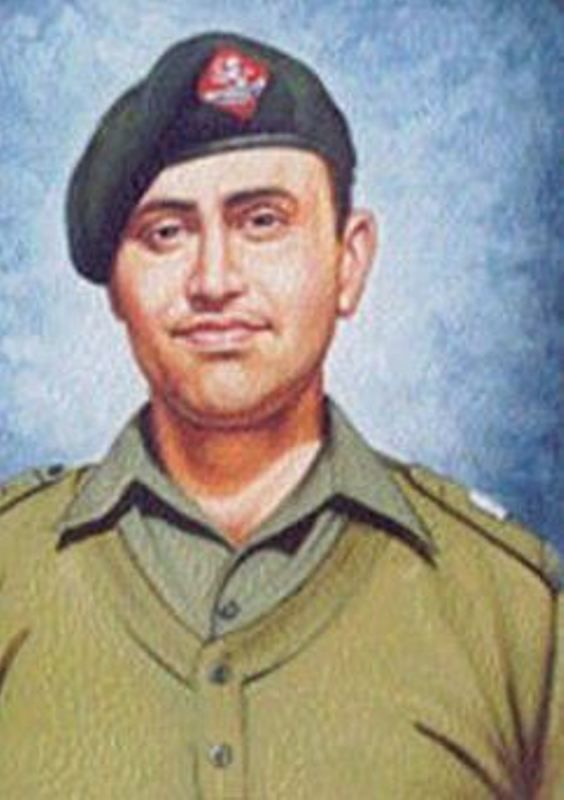Major Shaitan Singh Bhati was an officer in the Indian Army who fought the 1962 Sino-Indian War at Rezang La in Ladakh for which he was awarded the Param Vir Chakra, India’s highest gallantry award for his valiant actions. He was martyred on 18 November 1962 after being injured in the battle. He is often referred to as the Hero of Rezang La or as the Saviour of Ladakh.
Contents
Wiki/Biography
Major Shaitan Singh Bhati was born on Monday, 1 December 1924 [1]Honourpoint (age 37 years at the time of death) in the Jodhpur district of Rajasthan. He grew up in a family of military personnel that inspired him to join the military. He completed his schooling at Chopasni Senior Secondary School in Jodhpur, and on 1 August 1943, he joined Jaswant College where he completed his graduation in 1947.
He is also said to be a good football player in his school days. [2]Bravest of the Brave (Heroes of the Indian Army) by Kittu Reddy. After completing his graduation, he joined the Jodhpur State as an officer [3]Bravest of the Brave (Heroes of the Indian Army) by Kittu Reddy, and later, he was transferred to the Kumaon Regiment of the Indian Army when the Princely State of Jodhpur joined the Republic of India. He also participated in the 1961 Indo-Portuguese War after which Goa was annexed by the Indian forces. [4]Bravest of the Brave (Heroes of the Indian Army) by Kittu Reddy
Family & Caste
Major Shaitan Singh Bhati was born in a Rajput family that belonged to the Bhati clan of Rajputs [5]Stories of Heroism: PVC & MVC Winners by Chakravorty, B.C.
Parents & Siblings
His father, Lieutenant Colonel Hem Singh, was also an officer in the British Indian Army, who fought bravely during the First World War in France. [6]scrolldroll
Wife
He was married to Shagun Kanwar who passed away on 17 April 2015 at the age of 86. [7]The Times of India
Son
Major Shaitan Singh Bhati is survived by his son Narpat Singh Bhati who lives in Jodhpur. [8]Press Information Beaurau
Career
Early stepping stones in the career as a soldier
After completing his graduation, he joined the Durga Horse (now 61st Cavalry Regiment) of the erstwhile Jodhpur state as an officer cadet after which he went to Officers’ Training School at Poona, where he went through approximately two years of training, from 26 August 1947 to 31 July 1949. After his commissioning from the training, he joined Umed Kotah Infantry as an officer. After this, he moved to 20 Rajput (Jodhpur Sardar Infantry). After receiving his permanent regular commission, he joined the 13th Kumaon Regiment. [9]Rajput Military History & Military Personalities
Career as an Indian Army officer
After being transferred to the 13th Kumaon Regiment, Lieutenant Shaitan Singh Bhati actively participated in the anti-insurgency operations in the Naga Hills of Nagaland, where he was promoted to the rank of a Captain. He was also actively involved in the Indo-Portuguese War of 1961 when Goa was liberated by India. On 11 June 1962, he was promoted to the rank of Major when he was posted in the Eastern sector of Ladakh. [10]Bravest of the Brave: Heroes of the Indian Army by Kittu Reddy
The Battle of Rezang La and the Saga of Bravery
Initially, the 13th Kumaon was deployed at the Baramullah sector of Kashmir. But due to the government’s Forward Policy’s implementation, his unit was called for deployment at Chushul sector for the defence of Ladakh as small skirmishes had been taking place all along the Eastern border for over a month with the Chinese forces, and a Chinese invasion of Ladakh had become imminent. Major Shaitan Singh was the Company Commander of the Charlie Company of The Kumaon Regiment, which was tasked to defend the Ladakh region from any attacks that the Chinese forces might launch particularly on the Chushul airbase, which was crucial for sustaining Indian operations in the region. On the morning of 18 November 1962, at around 3.30 am the Chinese attacked the Indian positions with their full force. [11]Times Now After repeatedly thwarting the enemy, they were overrun by the enemy that was numerically superior to the Indian troops. Major Singh refused to retreat as per the orders and decided to take the last man, the last bullet stand. Out of the company of 120 men, 114 were killed in combat including Major Shaitan Singh. [12]Firstpost
Param Vir Chakra
For his heroic actions, Major Shaitan Singh Bhati was awarded Param Vir Chakra (posthumously) on 26 January 1963; the award was received by his wife, Shagun Kanwar. He was awarded the PVC for successfully repelling 7 consecutive enemy attacks on his position with limited manpower and resources at disposal. Despite being injured in the arm and abdomen he continued to motivate his men, and he defended the area till his last breath. [13]Param Vir: Our Heroes in Battle by Major General Ian Cardozo

Major Shaitan Singh’s wife Shagun Kanwar receiving PVC from the first President of India Dr S Radhakrishnan on behalf of her husband
Honours
- In the 1980s, the Shipping Corporation of India named one of its shipping tankers MT Major Shaitan Singh PVC to honour the gallant soldier. [14]Logistics Management for International Business: Text and Cases by Raj, Anthony S.; Shanmugam, Sudalaimuthu S
- Shaitan Singh’s native village has been named after him by the government to honour the martyr.
Achievement
He was awarded the Indian of the Year lifetime achievement award by CNN-IBN years after his death. [15]Be An Inspirer
Death
In the Battle of Rezang La, Major Shaitan Singh was grievously wounded in the arms and abdomen, he continued moving from one place to another under enemy fire in order to motivate his men and to prepare battle tactics. While being moved to safety, Shaitan Singh and his men were targeted by heavy enemy artillery fire, so he ordered his men to leave him behind and run for cover. He died due to excessive bleeding from his wounds on 18 November 1962. [16]ADGPI-Indian Army – Facebook Post

Last rites with full military honours for the soldiers of the 13th Kumaon Regiment who were killed in the battle of Rezang La
Facts/Trivia
- In the Battle of Rezang La, Major Shaitan Singh led a company of 120 men against approximately 5000 Chinese troops.
- When Shaitan Singh was fighting the Battle of Rezang La on 18 November 1962, the temperature recorded on the morning of that day was -24 degrees celsius. [17]The Financial Express
- When Major Shaitan Singh’s body was found, he was holding his weapon in his hands.
- The body of Major Shaitan Singh was found 3 months later by the Red Cross and the Army as the snow melted. [18]Honourpoint [19]DNA
- During the Battle of Rezang La, Major Singh and his company didn’t have any sort of support with them and were completely cut off whereas the Chinese had a lot of logistical and artillery support. [20]DNA
- Major Shaitan Singh’s father, Lieutenant Colonel Hem Singh, was awarded the Order of The British Empire [OBE], a gallantry award presented back then by the British to the soldiers of the commonwealth for showcasing exemplary courage. [21]scrolldroll
- Major Shaitan Singh sent one of the soldiers back so that he could tell the valiant tale of 120 men who fought at Rezang La. [22]scrolldroll)
- Major Singh’s watch was well known among his men, and he used to say, “I’ll die only if my watch stops”. When his body was found, he had his watch on his wrist that was recovered by the Indian Army.
S.S. Bhati
The West End Watch Co watch which witnessed Blood, Courage and Sacrifice. It witnessed The Battle of Rezang La. Wrist watch of Major Shaitan Singh, PVC which was recovered from his dead body.@adgpi @Maverickmusafir @37VManhas pic.twitter.com/U8rT2EzFoB
— Jai Samota (@jai_samota) December 25, 2021
- Major Shaitan Singh refused to be evacuated despite being severely injured in the battle of Rezang La.
- Nobody believed the story of Rezang La told by the survivors until 10 February 1963 when the Army’s own patrolling team, after being tipped off by a local shepherd, found the frozen remains of the soldiers who had died in the battle. ((Financial Express Capt. Kishori Lal, one of the members of the search team, later mentioned in his book titled The Gods of Valour about the search operation and how they found the bodies of martyred soldiers. He mentioned,
We reached Rezang La on 10 February 1963. There we saw the brave sons of mother Bharat sleeping in eternal sleep. We saw there was a heavy bombardment that the Chinese had done to wipe them out. There were deep pits all around. We picked up blind bombs and weighed them. Most of them were over 80 pounds. Each body of our valiant soldiers there had over thirty–thirty-five bullet wounds. As many as forty seven bullets had sunk into Jemadar (Naib Subedar) Hari Ram’s body. On one bunker shield, we counted 759 bullet holes.”
Another excerpt from the officially recorded statement of the Kumaon Regiment of the Indian Army clearly stated more information about the situation at Rezang La after the battle. It mentioned,
No bunker in Rezang La was found intact, corrugated iron sheets were found in bits, the ballies (wooden poles/logs used for making temporary shelters) had been reduced to matchwood sticks, and the sandbags were just shreds. But there was no sign of panic or withdrawal. Every single jawan was found dead in his trench; each had several bullets or splinter wounds, still holding their weapons; broken light machine guns/rifles bore witness to the intensity of the enemy fire. Jemadar (Naib Subedar) Hari Ram was found with a bandage on his head. He had apparently tied it in a hurry while rushing from one of his sections to another and was killed there: the body, when received, was still in crouching position.”
- After the battle of Rezang La, the Chinese were dissuaded from continuing their conquest of Ladakh, and on 21 November 1962, they unilaterally declared a ceasefire and retreated from Ladakh.
- Major Singh’s lifeless body was hidden away from the Chinese by one of the soldiers near a boulder.
- Major Shaitan Singh Bhati was one of the three Param Vir Chakra award recipients after the 1962 Sino-Indo war. [23]India Times
- Even though Major Singh was a company commander of the Kumaon Regiment, his troops were Ahirs and belonged to Haryana and Uttar Pradesh and none of them were Kumaonis. [24]Dainik Jagran
- The Theatre Honor of Laddakh (1962) and Battle Honour for Rezang La were presented to the 13 Kumaon Regiment due to the battle being fought there by 13 Kumaon’s Charlie Company under the leadership of Major Shaitan Singh.
- After the battle of Rezang La, the ‘C’ Company of the 13 Kumaon Regiment had to be re-raised as the company was completely wiped out at Rezang La. The Government of India honoured the newly raised Charlie Company by naming it as the Rezang La company. [25]ADGPI- Indian Army Official Facebook Post
- After Major Shaitan Singh refused to retreat, he gave his men the opportunity to retreat and didn’t enforce his order or decision upon them, but none of the soldiers decided to retreat, they rather decided to stand their ground to the end.
- Another reason why Major Singh and his men didn’t withdraw from their positions was to save a tiny village not far away from their actual position and had they vacated their positions, the village would have been completely annihilated by the advancing Chinese forces.
References
| ↑1, ↑18 | Honourpoint |
|---|---|
| ↑2, ↑3, ↑4 | Bravest of the Brave (Heroes of the Indian Army) by Kittu Reddy |
| ↑5 | Stories of Heroism: PVC & MVC Winners by Chakravorty, B.C. |
| ↑6, ↑21 | scrolldroll |
| ↑7 | The Times of India |
| ↑8 | Press Information Beaurau |
| ↑9 | Rajput Military History & Military Personalities |
| ↑10 | Bravest of the Brave: Heroes of the Indian Army by Kittu Reddy |
| ↑11 | Times Now |
| ↑12 | Firstpost |
| ↑13 | Param Vir: Our Heroes in Battle by Major General Ian Cardozo |
| ↑14 | Logistics Management for International Business: Text and Cases by Raj, Anthony S.; Shanmugam, Sudalaimuthu S |
| ↑15 | Be An Inspirer |
| ↑16 | ADGPI-Indian Army – Facebook Post |
| ↑17 | The Financial Express |
| ↑19, ↑20 | DNA |
| ↑22 | scrolldroll)
|
| ↑23 | India Times |
| ↑24 | Dainik Jagran |
| ↑25 | ADGPI- Indian Army Official Facebook Post |


















